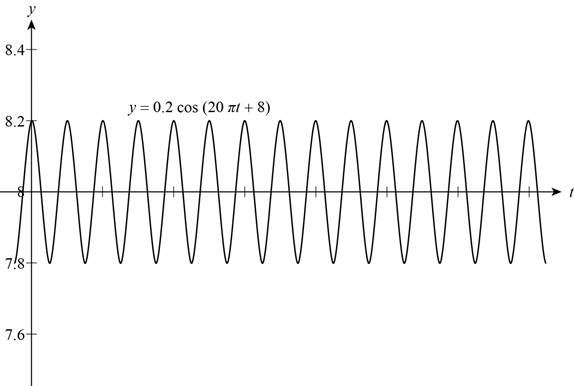
A Bobbing Cork A cork floating in a lake is bobbing in simple harmonic motion. Its displacement above the bottom of the lake is modeled by
where y is measured in meters and t is measured in minutes.
- (a) Find the frequency of the motion of the cork.
- (b) Sketch a graph of y.
- (c) Find the maximum displacement of the cork above the lake bottom.
(a)
The frequency for the motion of the cork floating in a lake.
Answer to Problem 27E
The frequency of a cork in simple harmonic motion is 10 cycles per minute.
Explanation of Solution
Given:
The equation for the displacement above the bottom of the lake is,
Where, y is in meters and t is in minutes.
Definition:
The equation for the simple harmonic motion which describes the displacement y of an object at time t is,
Where, A is the amplitude, b is the phase and k is the constant.
Calculation:
The equation for the displacement of the cork is,
The general equation for the displacement is,
Compare both the equation (1) and (2), the value of k is
The formula to calculate frequency of the cork is,
Substitute the value
Thus, the frequency of the cork is 10 cycles per minute.
(b)
To sketch: The graph for the cosine curve
Explanation of Solution
Sketch the graph for the cosine curve

Figure (1)
From the Figure (1), it is showed that graph is the cosine curve with oscillation between positive amplitude
(c)
The maximum displacement of the cork above the bottom of the lake.
Answer to Problem 27E
The maximum displacement for the cork is
Explanation of Solution
The amplitude of the cork is 0.2.
The equation for the displacement of the cork is,
For the maximum displacement of the cork, the cosine function must be maximum,
So, the cosine function is maximum at
Substitute 0 for t in equation (3),
Solve the equation,
Thus, the value of maximum displacement is
Chapter 5 Solutions
Precalculus: Mathematics for Calculus - 6th Edition
- Question Given the graph of f(z) below, identify the graph of f'(z). Select the correct answer below: -7-6-5-4-3-2 1 2 3 4 5 6 + 123. -7-6-5-4-3 12 + 4-3-2-1 1arrow_forwardFind this expression in frequency domain in a expression y(t), in time, that is.arrow_forwardplease dont use chat gptarrow_forward
- Question Given the graph of f(z) below, find the graph of the derivative of f(z). Select the correct answer below: ° 7-6-5-4-3 123 ° ° 2 -7-6-5-4-3- 123 -° 2-4 -°- °- -7-6-5-4-3-2-1 1 5 +arrow_forwardWhich of the functions shown below is differentiable at = 0? Select the correct answer below: -7-6-5-4- -6-5-4-3-21, -7-6-5-4-3-2 -7-6-5-4-3-2-1 2 4 5 6 -1arrow_forwardcorrect answer is Acould you please show me how to compute using the residue theoremarrow_forward
 Calculus: Early TranscendentalsCalculusISBN:9781285741550Author:James StewartPublisher:Cengage Learning
Calculus: Early TranscendentalsCalculusISBN:9781285741550Author:James StewartPublisher:Cengage Learning Thomas' Calculus (14th Edition)CalculusISBN:9780134438986Author:Joel R. Hass, Christopher E. Heil, Maurice D. WeirPublisher:PEARSON
Thomas' Calculus (14th Edition)CalculusISBN:9780134438986Author:Joel R. Hass, Christopher E. Heil, Maurice D. WeirPublisher:PEARSON Calculus: Early Transcendentals (3rd Edition)CalculusISBN:9780134763644Author:William L. Briggs, Lyle Cochran, Bernard Gillett, Eric SchulzPublisher:PEARSON
Calculus: Early Transcendentals (3rd Edition)CalculusISBN:9780134763644Author:William L. Briggs, Lyle Cochran, Bernard Gillett, Eric SchulzPublisher:PEARSON Calculus: Early TranscendentalsCalculusISBN:9781319050740Author:Jon Rogawski, Colin Adams, Robert FranzosaPublisher:W. H. Freeman
Calculus: Early TranscendentalsCalculusISBN:9781319050740Author:Jon Rogawski, Colin Adams, Robert FranzosaPublisher:W. H. Freeman
 Calculus: Early Transcendental FunctionsCalculusISBN:9781337552516Author:Ron Larson, Bruce H. EdwardsPublisher:Cengage Learning
Calculus: Early Transcendental FunctionsCalculusISBN:9781337552516Author:Ron Larson, Bruce H. EdwardsPublisher:Cengage Learning





